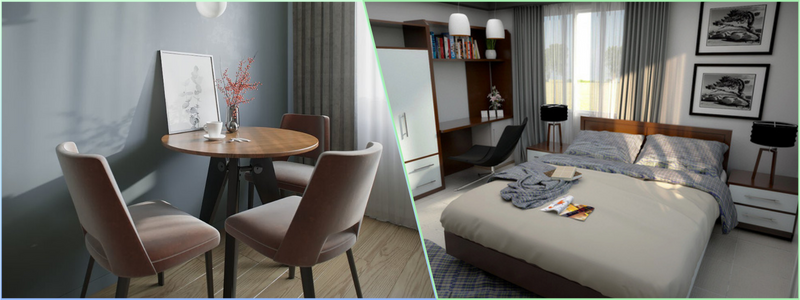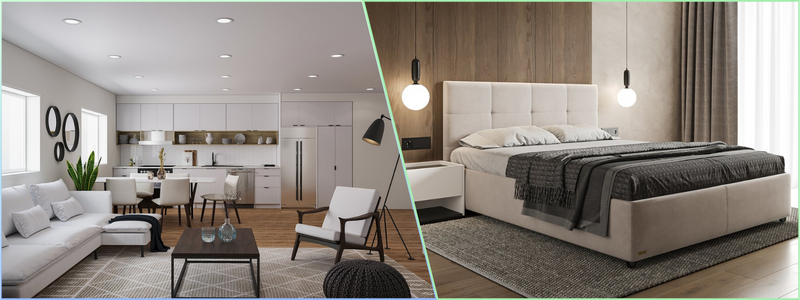How can your company utilize 3D furniture visualization for creating premium-standard content? Online shopping has become the trend, and customer expectations regarding furniture purchases have also changed drastically. If you want your furniture company to stay ahead of the game, you must create premium content to set you apart. Previously, furniture catalogs contained 2D images of each furniture piece. However, these simple and sometimes dull images are insufficient as consumers become more visual. Instead of product photography, it is time for furniture companies to consider and harness the potential of 3D furniture visualization.
 Table of contents
Table of contents
What is 3D Furniture visualization?
3D visualization services for furniture design involve using CGI technology to develop different types and forms of furniture models. It has become the most powerful and effective way to showcase almost any product, such as furniture, because it is easily customizable and hyper-realistic.
RELATED: How to get the best 3D rendering services for furniture design
Different types of 3D furniture renderings
3D furniture renderings are used during the 3D visualization process to cater to customers’ and clients’ diverse needs and demands. Here are some of the most popular types that furniture companies may need for the 3D furniture visualization process:
Detailed furniture renders
One of the most significant advantages of the 3D furniture visualization process is that it makes it easier to highlight features. The most common problem with traditional drawings and prototypes is this lack of details. With a physical drawing, you won’t be able to zoom in and out, nor can you update your prototype with small details.
On the other hand, 3D renderings let you showcase even the minutest details, thanks to the extremely high resolution of images. Customers can see and scrutinize all the furniture design’s embellishments, textures, and other peculiarities.
RELATED: How CGI can help marketing for your furniture business
Lifestyle images
3D furniture rendering companies offer a great way to give your customers a unique and unforgettable experience. Lifestyle images, in particular, can be a powerful and effective selling tool for your furniture company. Selling a lifestyle rather than the product alone is a popular marketing method. Creating a natural and realistic setting with your new 3D furniture visualization designs will make your customers more drawn to or connected to your products.
Customers appreciate it when they can imagine themselves using a product. They are interested in knowing whether the product will be in perfect harmony with their everyday life, how a piece of custom-designed furniture will make their living spaces look better, and how the same piece will make them feel the moment they buy and use it. This is what makes lifestyle images an effective way to lure customers and convince them to buy your furniture.
Simple studio renders
Simple studio renders are developed with a plain white backdrop, and the furniture itself is the focal point without other distractions. Although many 3D furniture designers prefer white backgrounds, this is not a definitive rule. You can incorporate a splash of color into the environment if it doesn’t overcrowd the image with unnecessary details. As the name implies, simplicity is the best way to go here.
RELATED: 3D Rendering furniture vs. photography: which is better for your furniture company?
These 3D furniture renderings are a favorite for product displays in online stores such as IKEA, eBay, Amazon, or Etsy. Isolating the image of your furniture this way can create an excellent selling tool that will focus on nothing else but the product itself to give customers a chance to see and appreciate it in its evident glory.

Teaser renders
3D furniture renders are also great marketing teasers for upcoming and soon-to-release furniture models or products. 3D furniture visualization teasers spark curiosity which can drive more sales once the product finally hits the market. You have endless options here, from teaser videos to product images or a glimpse of one part of the product.
Benefits of 3D furniture visualization process for your company
As expected, taking advantage of 3D furniture modeling services as part of your production and marketing strategy can help your company’s growth and success. 3D furniture renders can attract more customers and give all parties involved a better experience overall. The following are some of the benefits you can reap from using 3D furniture visualization:
RELATED: How furniture prototyping gives you an advantage during the manufacturing process
Improved furniture design
3D furniture renderings allow you to visualize the entire process from the ground up. Aside from the ability to identify and fix any possible errors before the start of manufacturing, you can also easily customize any aspect of the design. You can quickly change the background, textures, colors, and other elements to give your customers and clients the best results.
Enhanced visual communication
The 3D furniture visualization process can support your marketing campaigns, resulting in better sales and higher ROI. The 3D furniture CAD design expert can help you create stunning ads that spur massive pre-order sales. This saves you from the need to hire expensive photographers. You will even get beautiful images for your social media and web pages.
RELATED: 17 Ways how 3D rendering helps when marketing your furniture company
Tell a story easily
Telling a story is the main focus of the interior design. Customers want to give their families an enjoyable and comfortable living space, and furniture plays a big role here. 3D furniture designs can show off the 3D furniture designer’s ideas in the best possible light to help them tell a story that can engage customers and convince them to purchase.
Different Stages of the 3D furniture visualization process
The 3D furniture visualization process comprises five essential steps. It begins with 3D modeling of the furniture product. The 3D rendering studio will then set a scene that can be customized or ready-made. This will be followed by selecting the materials and applying textures on every 3D object in the background and the main furniture piece. The 3D rendering designer will set lighting and angles to ensure that things will look photorealistic as possible. The last step is the rendering process which involves the correct settings and post-production if needed. Now, let’s delve further into the details of the procedure.
RELATED: 3D Furniture visualization and rendering process: How to create high-end 3D content
1. Develop a bare polygon model
The 3D furniture rendering team will start working immediately after the studio receives your company’s item references. The 3D artist will begin by creating a 3D model, which is a chunk of blank polygons, by making the necessary adjustments to the camera angle to present the product from the best points of view. In this case, three to five best shots are already more than enough to help demonstrate every selling point of the furniture piece.
2. Set the 3D scene
The furniture itself is half of the lifestyle image, and the other half is all about the scene where it is set. Realistic 3D furniture rendering must develop an organic context for the furniture while keeping the item in the middle of the image, which can be considered subtle art. For example, if the furniture being sold is a dining table, it should be placed in the dining area with all the appropriate elements around it. This way, potential customers will imagine how the table will fit and blend in with their space.
RELATED: Augmented reality: AR as a great marketing tool for furniture industry companies
3. Identify the sources of light
After the 3D furniture modeling designer has finished the model and the points of view are set, the next stage of the 3D furniture visualization process is the placement and adjustment of the lighting sources. Lighting is critical to any room set composition and requires careful placement and editing. Light sources mainly depend on the specific type of furniture and the room where it is meant to be used. The 3D artist will determine whether the light should be dispersed, direct, artificial, natural, cold, or warm. Less prominent light sources will also be updated to make them look perfect. A professional 3D furniture rendering ensures nothing is out of place.

4. Give texture to the objects
In this step, the white skeletons will now get skin. Texturing is a critical stage of the 3D furniture visualization process because all textures must be natural-looking and highlight the items and their material quality. Some surfaces may be reflective, which must also be considered in the meticulous fixing of the visualization.
RELATED: Furniture catalog: top 5 ways that 3D product rendering can help your sales
5. Incorporate additional décor elements and use Photoshop to run images
Since the 3D furniture visualization process is almost finished, 3D artists can now add several décor elements that will further solidify the context to set the scene to render and for visual storytelling. Once the images are finished, Photoshop experts may run corrections to the colors and add some special effects for a more stunning 3D visualization. The 3D furniture visualization process is hours of hard work and skill from 3D rendering designers. By working with the experts, your company can look forward to gorgeous and impeccable 3D furniture visualization results that will serve as magnets for your customers and clients!
How Cad Crowd can help
Whether you are a small business or working in a large company, Cad Crowd can assist in connecting you with one of our vetted designers for a variety of 3D rendering projects! Tell us your budget, and a few details of what you are hoping to achieve and we’ll handle the rest. Get a free quote today!
